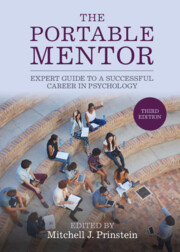Book contents
- The Portable Mentor
- The Portable Mentor
- Copyright page
- Dedication
- Contents
- Figures
- Tables
- Boxes
- Contributors
- Preface
- Acknowledgments
- Part I Applying to Graduate School
- Part II Beginning your Career
- Part III Your Research/Academic Career
- 11 An Open Science Workflow for More Credible, Rigorous Research
- 12 Presenting Your Research
- 13 Publishing Your Research
- 14 Recommendations for Teaching Psychology
- 15 Applying for NIH Grants
- 16 On Being a Woman in Academic Psychology
- Part IV Your Career as a Practitioner
- Part V Your Professional Service Career
- Part VI Your Career After Graduate School
- Index
- References
12 - Presenting Your Research
from Part III - Your Research/Academic Career
Published online by Cambridge University Press: 21 July 2022
- The Portable Mentor
- The Portable Mentor
- Copyright page
- Dedication
- Contents
- Figures
- Tables
- Boxes
- Contributors
- Preface
- Acknowledgments
- Part I Applying to Graduate School
- Part II Beginning your Career
- Part III Your Research/Academic Career
- 11 An Open Science Workflow for More Credible, Rigorous Research
- 12 Presenting Your Research
- 13 Publishing Your Research
- 14 Recommendations for Teaching Psychology
- 15 Applying for NIH Grants
- 16 On Being a Woman in Academic Psychology
- Part IV Your Career as a Practitioner
- Part V Your Professional Service Career
- Part VI Your Career After Graduate School
- Index
- References
Summary
Dissemination of psychological science is vital to the field, and there is a number of reasons why trainees and professionals in the discipline are motivated to present their work. There are several different venues available for presentations, and each might host a range of formats. The most common types of presentations include posters, symposia, panel discussions, or workshops. When preparing and conducting presentations, there are key tips to consider to optimize success. For example, it is critical that the presenter read through the venue requirements, which vary considerably. There are also key items to bring to conferences in case of technological or other problems. Repeated practice with critical colleagues in advance of the presentation is recommended to increase the chance of a good delivery in the more stressful circumstances with an audience. The advice and guidance provided in this chapter should help the presenter navigate the intricacies of presenting research. In fact, appropriate preparation and practice for presentation will likely lead to a highly gratifying experience for the presenter and audience.
- Type
- Chapter
- Information
- The Portable MentorExpert Guide to a Successful Career in Psychology, pp. 217 - 234Publisher: Cambridge University PressPrint publication year: 2022



